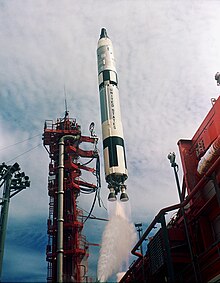Titan II GLV
 Launch of Gemini 11 on a Titan II GLV from LC-19 | |
| Function | Human-rated launch vehicle for Gemini spacecraft |
|---|---|
| Manufacturer | Martin |
| Country of origin | United States |
| Size | |
| Height | 109 feet (33.2 m)[1] |
| Diameter | 10 feet (3.05 m) |
| Mass | 340,000 pounds (154,200 kg) |
| Stages | 2 |
| Capacity | |
| Payload to LEO | |
| Mass | 7,900 pounds (3,580 kg) |
| Associated rockets | |
| Family | Titan |
| Launch history | |
| Status | Retired |
| Launch sites | Cape Canaveral LC-19 |
| Total launches | 12 |
| Success(es) | 12 |
| First flight | April 8, 1964 |
| Last flight | November 11, 1966 |
| Type of passengers/cargo | Gemini |
| First stage | |
| Powered by | 1 LR-87 |
| Maximum thrust | 430,000 pounds-force (1,913 kN) |
| Specific impulse | 258 sec |
| Burn time | 156 seconds |
| Propellant | Aerozine 50/N2O4 |
| Second stage | |
| Powered by | 1 LR-91 |
| Maximum thrust | 100,000 pounds-force (445 kN) |
| Specific impulse | 316 sec |
| Burn time | 180 seconds |
| Propellant | Aerozine 50/N2O4 |
The Titan II GLV (Gemini Launch Vehicle) or Gemini-Titan II was an American expendable launch system derived from the Titan II missile, which was used to launch twelve Gemini missions for NASA between 1964 and 1966. Two unmanned launches followed by ten manned ones were conducted from Launch Complex 19 at the Cape Canaveral Air Force Station, starting with Gemini 1 on April 8, 1964.
The Titan II was a two-stage liquid-fuel rocket, using a hypergolic propellant combination of Aerozine 50 fuel and nitrogen tetroxide oxidizer. The first stage was powered by an LR87 engine (with two combustion chambers and nozzles, fed by a single set of turbomachinery), and the second stage was propelled by an LR-91 engine.
Modifications from the Titan II missile
In addition to greater payload capability, the Titan II promised greater reliability than the Atlas LV-3B which had been selected for Project Mercury, because Titan's hypergolic-fueled engines contained far fewer components.
Several modifications were made to the Titan missile to man-rate it for Project Gemini:
- A Gemini Malfunction Detection System was installed to inform the crew of the rocket's status, and improve response in an emergency.
- Redundant systems were fitted to reduce the chances of launch failures.
- To help guard against the possibility of a guidance malfunction causing the engine nozzles to gimbal hard right or left, an extra backup guidance system was added.
- The second stage propellant tanks were lengthened for longer burn time and unnecessary vernier engines and retro-rockets were removed. Because the second stage engine had had issues with combustion instability, it was equipped with baffled injectors.
- A radio control system replaced the inertial guidance used on the missiles.
- Modifications were made to the tracking, electrical and hydraulics systems in the interest of improved reliability.
Modifications were overseen by the Air Force Systems Command. Aerojet, the manufacturer of the Titan's engines, had released a revised model during mid-1963 due to deficiencies in the original design and also attempting to improve manufacturing procedures.
Assembly was done at Martin-Marietta's Baltimore plant so as not to interfere with missile work at the Denver facility, although it also saved the former from a planned shutdown.[2]
Flights

| Mission | LV Serial No | Launch date | Crew |
|---|---|---|---|
| GT-1 | GLV-1 12556 | April 8, 1964 | Unmanned orbital test flight |
| GT-2 | GLV-2 12557 | January 19, 1965 | Unmanned suborbital test of Gemini heat shield |
| GT-3 | GLV-3 12558 | March 23, 1965 | Gus Grissom and John Young |
| GT-IV | GLV-4 12559 | June 3, 1965 | James McDivitt and Edward H. White |
| GT-V | GLV-5 12560 | August 21, 1965 | Gordon Cooper and Charles P. Conrad |
| GT-VII | GLV-7 12562 | December 4, 1965 | Frank Borman and James Lovell |
| GT-VI A | GLV-6 12561 | December 15, 1965 | Wally Schirra and Thomas P. Stafford |
| GT-VIII | GLV-8 12563 | March 16, 1966 | Neil Armstrong and David Scott |
| GT-IX A | GLV-9 12564 | June 3, 1966 | Thomas P. Stafford and Eugene Cernan |
| GT-X | GLV-10 12565 | July 18, 1966 | John Young and Michael Collins |
| GT-XI | GLV-11 12566 | September 12, 1966 | Charles P. Conrad and Richard F. Gordon |
| GT-XII | GLV-12 12567 | November 11, 1966 | James Lovell and Edwin "Buzz" Aldrin |
See also
Notes
- ^ Gatland, Kenneth (1976), Manned Spacecraft (2nd revision ed.), New York: MacMilan, p. 37, ISBN 0-02-542820-9
- ^ http://ntrs.nasa.gov/archive/nasa/casi.ntrs.nasa.gov/19780012208_1978012208.pdf
References
- Krebs, Gunter. "Titan-2-GLV". Gunter's Space Page. Retrieved April 29, 2009.
- Wade, Mark. "Titan". Encyclopedia Astronautica. Retrieved April 29, 2009.
External links
![]() Media related to Titan II Gemini at Wikimedia Commons
Media related to Titan II Gemini at Wikimedia Commons


